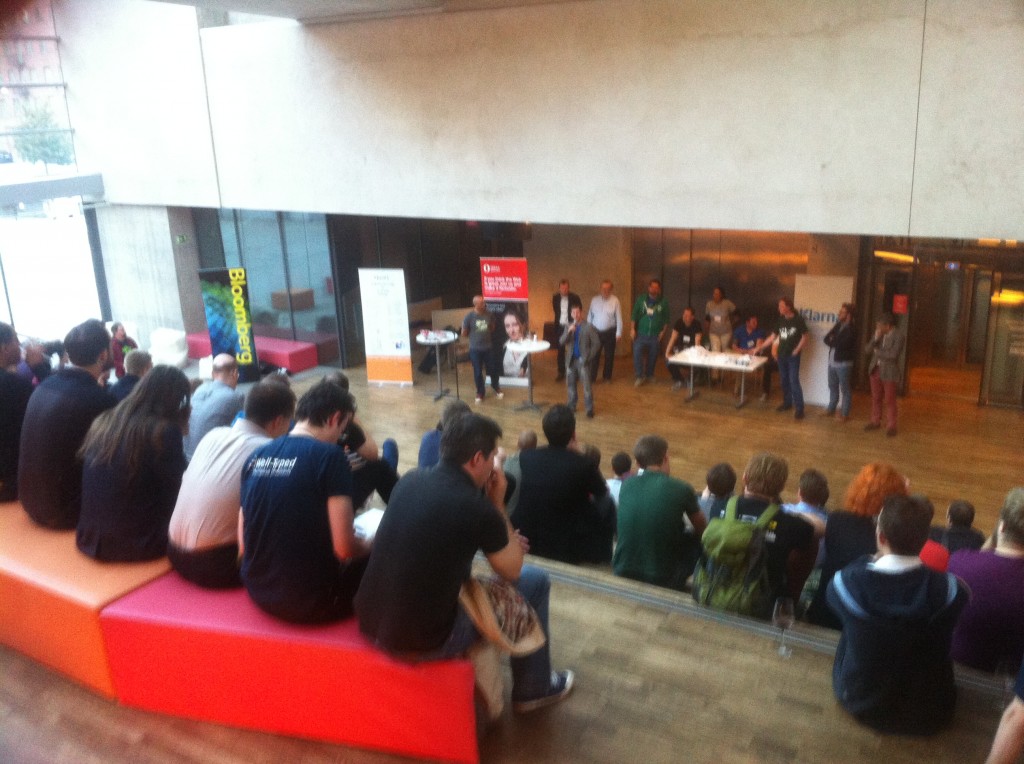Programming Languages Mentoring Workshop (PLMW)
Good morning from POPL 2015 in Mumbai, India.
Throughout this blog, * denotes a notation heavy segment in the talk. These can be difficult to summaries quickly without typesetting. See the authors paper online for now and I'll try to find speaker slides at the later time.
PLMW Organizers - Intro
This is the 4rd PLMW workshop and we are very pleased to see you all. Mentoring workshops are now being much more common. This year we have funded 75 students. We would like the thank the speakers, sponsors and organisers (including Annabel :)
Video from Derek
POPL proceedings are now available online
Nate Foster (Cornell University) - You and Your Graduate Research
Prelude:
- doing a PhD is not easy, many do not finish. This is a survivors story
- some of my comments many be US specific
- acknowledgements (including Jorge Cham from PhD comics :))
Motivation
THis is useful from everyone, not just undergraduates.
Why you shouldn't do it?
- money: nick shows a graph of salaries in university, football coaching is clearly the right way to go for a big salary.
- start-ups: Tech start-ups are now a top topic, Oculus VR example and you don't need a PhD for this
- respect: Education is highly valued and there's respect from degrees, but no one will call you doctor exact your mom.
- to stay in school: Undergraduate was fun so lets stay in school, a PhD program is totally different.
- being a professor: Let all become a professor, demonstration of the numbers of academics verse other careers
Why you should?
- opens opportunities
- cool jobs in industry: leadership, work on cool problems, you can work on large systems and with real users
- freedom: applies on any level, freedom to choose interesting problems, opportunities to work on the big problems
What is a PhD?
Comparing degrees at different levels:
- high school: basics for life
- undergrad: broad knowledge in a field
- professional: advanced knowledge and practical skills
- PhD: advanced knowledge and a research contribution.
PhD is open edge
PhD is a transformation - we start with intelligent people who aren't researchers. Its a apprentice based scheme to being a researcher. Its not an easy or painless process.
PhD Success
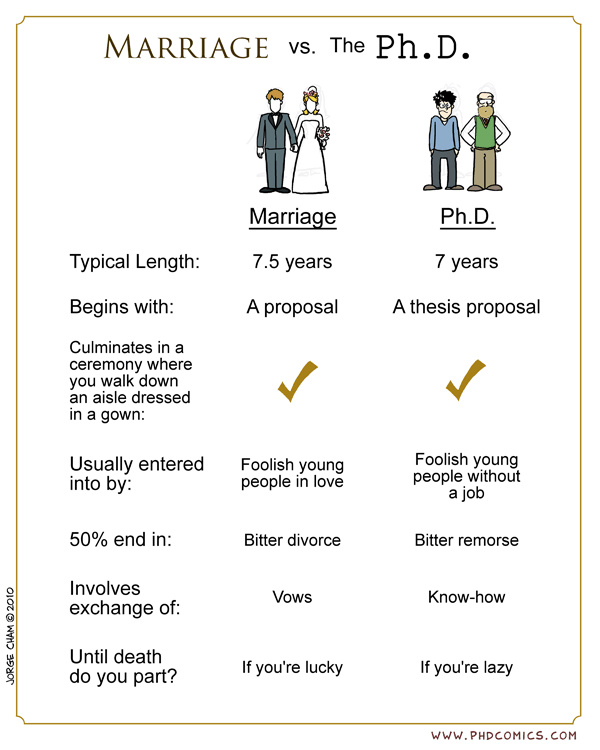
pick an institution
The community that your in will shape your work,
Very important factors include advisor, opportunities and peers. Typically less important factors are finances, institution and location.
Dive into Research
Don't be distracted by other things e.g. classes and teaching
Pick great problems
"It is better to do the right problem the wrong way than the wrong problem the right way" - Hamming
Stay Engaged
Working with others means it easier, as you can motivate each other.
Know when its time to switch topics - good research are versatile and able to switch quickly
Independence - you need to know when the time is right to go rogue and ignore your adviser
Reaching escape velocity to graduate

Peter Müller (ETH Zürich) - Building automatic program verifiers
verification: Given a program P and a specification S, prove that all execution of P satisfies S
automatic verification: Develop an algorithm that decide whether P satisfies S
We can't prove halting => we are finished :)
Lets start again ...
Peter demonstrates of verification tool called Viper, using the typical account balance and transfer example. The verifier gives two error, we add preconditions and the verifier successes. We then use the verifier for thread safety, again fixing a concurrency bug with locking.
Automatic verification is not b/w. We can have semi-automatic verification: we can guide the verifier. The complexity of the code varies greatly, most success in the area focuses on a small area. We build verifiers from weaker guarantees. Verification can working with modularity (or maybe it will not). Varying complexity of properties.
7 Stage process
Define the research goals
What is the state of the art?
Find examples the area in the problem space that is not currently handled (well) by current verifiers.
Find Reasoning Principle
How to explain the correctness of the code to a friend? For the loop, we would use a loop invariant.
This is very different to techniques like model checking, I wouldn't say to friend "I have checked 15 billion possible evaluation paths and are all valid".
Break Down Arguments
Decompose the correctness argument: what do I need to prove for each program and what can I reuse between programs. How can I modularise the program.
Design Specification Language
Designing a language to express intended behaviour, we must know who the user will be and their level of experience. Find the right compromise between expressibility and simplicity, that is right for the intended audience.
Design Program Logic
Determine which properties need to be checked and which properties may be assumed.
Automate Proof Search
Utilize existing infrastructure like SAT and SMT solvers. Develop decision procedures for aspects not already covered by existing infrastructure.
Evaluate the Solution
Firstly an experimental evaluation, does the solution work on the example code you were executing. Then he meta-theory like the soundness proof.
Research Direction
Either develop now technical for new languages and feature (e.g. the recent interest in event-bases programming due to android.) or work in general infrastructure for utilise in many areas.
Frank Pfenning (Carnegie Mellon University) - Proof theory and its role in programming language research
I will show you why every PL researcher needs a bit of proof theory.
How do we write correct programs ?
We don't :)
In practice, programming and informal reasoning go hand in hand, we use mental logical assertions, e.g. after calling sort the list is sorted. It's vital to decompose the problem into part so we can reason locally.
We need to develop programming language with the logic of the programmer in mind. Think about your least favourite programming language and why the operational or logical model of the languages doesn't agree with you. Reasoning is an integral part of programming. We need to co-design the language and logic for reasoning about it.
Logic is computation so the key is to design coherent logical and operations semantics.
Examples:
Computation first...
- runtime code generation => IS4
- partial eval => temporal logic
- dead code ele => model logic
- distribution computation => IS5
- message-passing
- concurrency => linear logic
- generic effects => lax logic
... and the logics first
- lax logic => ??
- temporal logic => ??
- epistemic logic => ??
- ordered logic => ??
Key ingredients.
Understand the difference between judgements and propositions. The basic style of proof systems e.g. natural deduction, sequent calculus, axiomatic proof system and binary entailment.
Example: Hypothetical Judgement*
Example: Runtime Code Generation
We have the source expression at runtime. We distinguish ordinary variable which are bound to values and expression values which are bound to source code.*
Stephanie Weirich (University of Pennsylvania) - How to write a good research paper
Stephanie is giving the popular talk "How to write a good research paper" from Simon Peyton Jones.
Start by writing the paper. It focuses us. Write a paper about any idea no matter now insignificant it seems. Then you develop the idea.
Identify your key idea, the paper main goal is to convey your idea. Be explicit about the main idea for the paper, the reviews should need to be a detective.
The paper flow:
- Here is a problem
- It's an interesting problem
- It's an unsolved problem
- Here is my idea
- My idea works
The introduction - describe the problem and what your paper contributes towards to problem. Don't describe the problem to broadly to quickly. It's vital to nail the exactly contributions.
The related work - it belongs after the main body of the paper, not straight after the introduction. Be nice in the related work. Be honest about the weaknesses of your approach.
Use simple, direct language, putting the reader first. Listen to readers.
Damien Pous (CNRS, LIP, ENS Lyon) - Coinductive techniques, from automata to coalgebra
Checking language equivalence of finite automata
Demonstration of the naive algorithm to compare equivalence by walking through the stages and comparing. This algorithm is looking for bi simulation. This algorithm has quadratic complexity. Instead we can used HK (Hopcroft and Kerp) algorithm.
[I got a bit lost in the theory of coalgebras for the rest of the talk, sorry]*
ML Family Workshop
Welcome to the ML Family workshop liveblog with Leo, our guest blogger Gabriel Scherer and myself.
Welcome
Welcome, this year we worked closely with the OCaml workshop to give the two workshops they're own focus, this workshop is more theory focused then the OCaml workshop. This workshop doesn't just include features in current SML, but also features that could be included in the future. We welcome all ML's from the ML family. We will be publishing the proceeding and they will be available free online.
Session 1: Module Systems
Chair: Didier Rémy
1ML -- core and modules as one (Or: F-ing first-class modules) (Research presentation)
Andreas Rossberg
Abstract: We propose a redesign of ML in which modules are first-class values. Functions, functors, and even type constructors are one and the same construct. Likewise, no distinction is made between structures, records, or tuples, including tuples over types. Yet, 1ML does not depend on dependent types, and its type structure is expressible in terms of plain System F-omega, in a minor variation of our F-ing modules approach. Moreover, it supports (incomplete) Hindley/Milner-style type inference. Both is enabled by a simple universe distinction into small and large types.
We are rethinking the design of ML. We talk about ML as a language, its actually at least 2.5 languages. There is the core language and the module language. There's even a 3rd language of type expression. This are all syntactically different.
Who likes the type expression syntax in ML ? No-one
Modules in ML, as 2nd class. Modules are more verbose but powerful, leaving us with some difficult decisions. There has been work in packing modules as fist class values.
We want a classless society !
I want the expressive power of modules, with style.
I propose 1ML - first class modules language/ unified ML
No more staring with core language and add modules constructs. Instead we start with a module language and then add some core constructs.
Example of explicit typed 1ML: Similar to ML plus two functor types, one for pure and one for inprue. Type declaration syntax is replaced with anonymous modules.
Examples of types as modules: This common in module IL's, its not too new.
This extends to type constructors as applicative functors.
The unavoidable map functor example :)
A more interesting example: The textbook example of selection something at runtime. This could be done in OCaml but it would be much more verbose.
Example of collection to demonstrate associated types. Examples of how this can again be achieved in OCaml but its still more verbose.
Example code using higher kinded polymorphism, which couldn't be do in OCaml
I am using F-ing modules semantics and collapsing syntax and semantics.
Challenges: Decidability for subtypes, phase separation and type interface. The avoidance problem wasn't a problem at all.
Decidability: The ability to have abstract signatures can introduce decidability issues. Matching can lead in infinite sequence of substitution.
We disallow substitution an abstract types. This is also in papers from the 80's. We separate types into polytypes and monotypes. Only small types can have type type'.
Example of F'ing types definition for large and small types.
Phase separation: Not a problem
Type inference: We will only infer small types, so annotations can be omitted. We can recover ML style polymorphism with implicit functions.
Revisiting the Map example with all the type annotations.
Inference and subtypes: Subtyping relations almost degenerates to type equivalence on small types.
Incompleteness: Subtyping allows width subtyping, Include is a form of record concatenation and value restriction inside functors.
SML can't infer any of this either !
F-ing modules is almost a first class module language. Truly first-calls modules are perfectly doable without regressing the language. Isolate the essence of ML's core/modules.
Future: Generalise applicative functors, Generalise implicit functors (aka type classes ?), Row polymorphism, more sophisticated inference for first class polymorphism, recursive modules. This + MixML nit be like Scala.
Q: Is predicativity something we might regret in the future ?
A: We have pack like construct for first class modules
Q: The last 10 years we have moved towards dependant types, you've seemed to move the opposite direction ?
A: Interesting question
Type-level module aliases: independent and equal (Research presentation)
Jacques Garrigue (Nagoya University); Leo White (University of Cambridge)
Abstract: We prom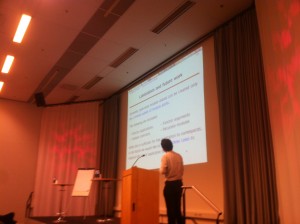 ote the use of type-level module aliases, a trivial extension of the ML module system, which helps avoiding code dependencies, and provides an alternative to strengthening for type equalities.
ote the use of type-level module aliases, a trivial extension of the ML module system, which helps avoiding code dependencies, and provides an alternative to strengthening for type equalities.
Type-level module aliases - a simple feature in OCaml 4.02
Writing ```module S = String``` in signature will alias S to string.
Introducing the new inferred type-level module aliases and how this extending the subtyping relation.
The concept of type-level modules alias appears first in Traviatta (ICFP '06), used to allow type interface of recursive modules.
Later we discovered that type-level modules aliases were a good match for OCaml-style applicative functors.
Helping applicative functors was probably not enough to justify a new feature. However remember that the original goal was to simplify program analysis.
Modules as name spaces: Sharing of types allow grafting a modules somewhere else in the hierarchy.
This idea only working in theory: for separate compilation things backtrack. We have a risk of name conflict in are libraries as forest of modules. -pack is monolithic, using modules as name spaces creates large interfaces (e.g. JS core).
How to other language handle this issue: SML using a compilation manage which use special files using a dedicated syntax.
Example of manual packing
Now adding type-level module alias. We do not need to duplicate the module signatures.
Induced dependencies - a new compilation flag -no-alias-deps for 4.02.
3 Steps:
- Create a mapping unit whose role is only to map short names to prefixed names
- open this unit
- create an export unit
Compared to using -pack, this approach requires rename source files to unique name and add an open statement.
In core/async this divides the size of compiled interfaces by 3,
Currently, type level modules aliases can be created only for a limited subset of module paths, this excludes feature like functor applications, opaque coercions, functor arguments and recursive modules.
C: This also reduces required false dependences.
Q: What's the meta theory of this ?
A: This wasn't part of this work but were working into normalisation in the OCaml compiler
C: We are also using kinda thing for backpack in Haskell
Q: Currently we use ocamldep, what will happen to this tool ?
Session 2: Verification
Chair: Anil Madhavapeddy
Well-typed generic smart-fuzzing for APIs (Experience report)
Thomas Braibant (Cryptosense); Jonathan Protzenko; Gabriel Scherer (INRIA)
Abstract: In spite of recent advances in program certification, testing remains a widely-used component of the software development cycle. Various flavors of testing exist: popular ones include unit testing, which consists in manually crafting test cases for specific parts of the code base, as well as quickcheck-style testing, where instances of a type are automatically generated to serve as test inputs.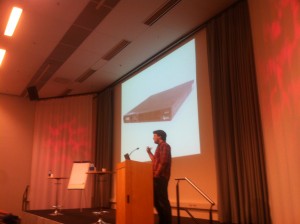
These classical methods of testing can be thought of as internal testing: the test routines access the internal representation of the data structures to be checked. We propose a new method of external testing where the library only deals with a module interface. The data structures are exported as abstract types; the testing framework behaves like regular client code and combines functions exported by the module to build new elements of the various abstract types. Any counter-examples are then presented to the user. Furthermore, we demonstrate that this methodology applies to the smart-fuzzing of security APIs.
I work for a start-up, work on hardware security models (HSM). Some hackers have been about to steal lots of money due to issues with HSM.
Cryptosense Workflow
Testing -> Learning -> Model-checking -> ...
We will focus on Testing, we automatically test API's using QuickCheck (a combinator library to generate test case in Haskell), But to generate tests we need to know how to generate our types/data structures.
ArtiCheck - a prototype library to generate test cases for safety properties. Comparison of QuickCheck of ArtiCheck.
Types help us to generate good random values, API's help generate values that have the right internal invariants.
Well-typed does not mean well-formed so we still need fuzzing.
Describing & Testing API's, we are only considering on first order functions.
Example of how we would test an example of API for red black trees.
Introducing a toy DSL for describing API's: describing types, functions and signatures.
There are many ways to combine these functions. so we introduce a richer DSL for types.
Field Report: Cryptosense
We need to enumerate a big combinational space made of constants and variables. We want good coverage and generate templates in a principle manor.
We have a library of enums with a low memory footprint with efficient access.
We have another DSL for describing combinatorial enumeration.
Example test results from a HSM. We have 10^5 test in 540 secs.
We have a principled way to test persistent APIs.
Writing a generator for testing BDD would be very tough without solutions like this.
Come work for Cryptosense :)
Q: How long does it take run the data on a real HSM ?
A: the numbers show actually already include already, we dynamically explore the state space.
Q: How do you trade-off coverage of API to coverage of state space ?
A: You a systematic approach. e.g. constantly generate trees which are bigger and bigger, so you don't just regenerate empty trees.
Q: Can you find a simple counterexample like QuickTest ?
A: Its not currently a function but maybe we can add a function to find an example smaller that exhibit the same behaviour
Q: Is this open source ?
A: Yes, the prototype is on github
Improving the CakeML Verified ML Compiler (Research presentation)
Ramana Kumar; Magnus O. Myreen (University of Cambridge); Michael Norrish (NICTA); Scott Owens (University of Kent)
Abstract: The CakeML project comprises a mechanised semantics for a subset of Standard ML and a formally verified compiler. We will discuss our plans for improving and applying CakeML in four directions: optimisations, new primitives, a library, and verified applications.
Introducing the CakeML team, we are verification people.
Why ML for verification: its clean and high level, its easy to reason about so can we then formally reason about it.
CakeML: a subset of ML which is easy to reason about, with verified implementation and demonstrate how easy it is to generate verified cakeML
How can we make proof assistant into trustworthy and practical program development platforms.
functions in HOL -> CakeMl -> Machine code
2 part to this talk:
- verified compiler
- making the compiler better
Highlights of CakeML compiler:
Most verified compiler work from source code to AST to IR to bytecode to Machine code. We take a difference approach and can do both dimensions in full.
The CakeML language, its SML without IO and functors. Since POPL '14 we've added arrays, vectors, string etc..
Contributions of POPL '14 paper: specification, verified algorithms, divergence preservation and bootstrapping. Proof developer where everything fits together.
Numbers: its slower, our aim is to be faster then interpreted OCaml.
The compiler phases are simple, we use only a few hops from IR to x86. Bytecode simplified proofs of real-eval-loop but made optimisation impossible.
We are now add many more IR's to optimise, like common compilers. Currently we only have x86 backend but we are adding ARM etc..
C: Inlining and specialisation of recursive functions are the key optimisations that you should focus on
C: You could use your compiler (written in cakeML) to evaluate the value of various optimisations
Q: Why don't you support functors ?
A: Its not a technical issue, this just a lot of work and its at the top of the priorities stack.
C: Your runtime value representation could make a big performance issues
C: Can you eliminate allocation in large blocks
Session 3: Beyond Hindley-Milner
Chair: Jacques Garrigue
The Rust Language and Type System (Demo)
Felix Klock; Nicholas Matsakis (Mozilla Research)
Abstract: Rust is a new programming language for developing reliable and efficient systems. It is designed to support concurrency and parallelism in building applications and libraries that take full advantage of modern hardware. Rust's static type system is safe and expressive and provides strong guarantees about isolation, concurrency, and memory safety.
Rust also offers a clear performance model, making it easier to predict and reason about program efficiency. One important way it accomplishes this is by allowing fine-grained control over memory representations, with direct support for stack allocation and contiguous record storage. The language balances such controls with the absolute requirement for safety: Rust's type system and runtime guarantee the absence of data races, buffer overflows, stack overflows, and accesses to uninitialized or deallocated memory. In this demonstration, we will briefly review the language features that Rust leverages to accomplish the above goals, focusing in particular on Rust's advanced type system, and then show a collection of concrete examples of program subroutines that are efficient, easy for programmers to reason about, and maintain the above safety property.
If time permits, we will also show the current state of Servo, Mozilla's research web browser that is implemented in Rust.
Motivation: We want to implement a next gen web browser servo
See the rusty playpen online http://www.rust-lang.org/
We want a language for systems programming, C/C++ dominate this space. We want sound type checking. We identify classic errors and using typing to fix them.
Well-typed programs help to assign blame.
Systems programmers want to be able to predict performance.
Rust syntax is very similar to OCaml. Types have to explicit on top-level functions. Rust has bounded polymorphism, we don't have functor, this is more similar to typeclasses.
Value model between OCaml and Rust is very different. Rust in-lines storage but must pick the size of the largest variant.
To move or copy ? Move semantics
The Copy bound expresses that a type is freely copyable and its checked by the compiler.
Many built-in types implement Copy
Why all the fuss about move semantics ?
Rust has 3 core types: non-reference, shared reference, mutable unaliased reference. (plus unsafe pointers etc..)
Rust patch matching moves stack slots. Rust introduces ref pattens and takes references to its interioa.
This is all more type soundness
Q: Is borrowing first order ? Can I give to someone else ?
A: Yes, I'll explain more later
Lifetimes: simulator to regions used by Tofte/Talpin
Example of sugar and de-suger forms of functions: how we can explicitly constrain lifetimes
Is every kind of mutability forced into a linearly passed type ?
Not really, there's inherited and interior mutability.
Rust has closures
Q: Does rust repeat earlier work on cyclone ?
A: Cyclone tried to stay very close to C but we more then happy to diverge from C/C++
Q: Large scale systems code becomes tanted with linearity, how do you deal with that ?
A: You can break out of it, only very occationally need to break into unsafe code
Q: How do you know that your type system is safe ?
A: There's ongoing work
Doing web-based data analytics with F# (Informed Position)
Tomas Petricek (University of Cambridge); Don Syme (Microsoft Research Cambridge)
Abstract: With type providers that integrate external data directly into the static type system, F# has become a fantastic language for doing data analysis. Rather than looking at F# features in isolation, this paper takes a holistic view and presents the F# approach through a case study of a simple web-based data analytics platform.
Experiments can have a life of its own independent of a large-scale theory. This is a relevant case study, theory and language independent and demonstrates a nice combination of language features
Demo: demo using type providers and translation from F# to JS.
Features used: type providers, meta-programming, ML tyoe inference and async workflows.
JS Intergration: questions on whether to use JS or F# semantics.
Asynchronous workflows - single thread semantics
Not your grandma's type safety,
Q: These language feature are good for specific application, do they make the language worse for other features ?
A: No the extensions use minimal syntax
Q: Is there version contrainting on type providers for data source ?
A: No
The rest of the posts will follow soon
Session 4: Implicits
Chair: Andreas Rossberg
Implicits in Practice (Demo)
Nada Amin (EPFL); Tiark Rompf (EPFL & Oracle Labs)
Abstract: Popularized by Scala, implicits are a versatile language feature that are receiving attention from the wider PL community. This demo will present common use cases and programming patterns with implicits in Scala.
Modular implicits (Research presentation)
Leo White; Frédéric Bour (University of Cambridge)
Abstract: We propose a system for ad-hoc polymorphism in OCaml based on using modules as type-directed implicit parameters.
Session 5: To the bare metal
Chair: Martin Elsman
Metaprogramming with ML modules in the MirageOS (Experience report)
Anil Madhavapeddy; Thomas Gazagnaire (University of Cambridge); David Scott (Citrix Systems R&D); Richard Mortier (University of Nottingham)
Abstract: In this talk, we will go through how MirageOS lets the programmer build modular operating system components using a combination of functors and metaprogramming to ensure portability across both Unix and Xen, while preserving a usable developer workflow.
Compiling SML# with LLVM: a Challenge of Implementing ML on a Common Compiler Infrastructure (Research presentation)
Katsuhiro Ueno; Atsushi Ohori (Tohoku University)
Abstract: We report on an LLVM backend of SML#. This development provides detailed accounts of implementing functional language functionalities in a common compiler infrastructure developed mainly for imperative languages. We also describe techniques to compile SML#'s elaborated features including separate compilation with polymorphism, and SML#'s unboxed data representation.
Session 6: No longer foreign
Chair: Oleg Kiselyov
A Simple and Practical Linear Algebra Library Interface with Static Size Checking (Experience report)
Akinori Abe; Eijiro Sumii (Tohoku University)
Abstract: While advanced type systems--specifically, dependent types on natural numbers--can statically ensure consistency among the sizes of collections such as lists and arrays, such type systems generally require non-trivial changes to existing languages and application programs, or tricky type-level programming. We have developed a linear algebra library interface that guarantees consistency (with respect to dimensions) of matrix (and vector) operations by using generative phantom types as fresh identifiers for statically checking the equality of sizes (i.e., dimensions). This interface has three attractive features in particular.
(i) It can be implemented only using fairly standard ML types and its module system. Indeed, we implemented the interface in OCaml (without significant extensions like GADTs) as a wrapper for an existing library.
(ii) For most high-level operations on matrices (e.g., addition and multiplication), the consistency of sizes is verified statically. (Certain low-level operations, like accesses to elements by indices, need dynamic checks.)
(iii) Application programs in a traditional linear algebra library can be easily migrated to our interface. Most of the required changes can be made mechanically.
To evaluate the usability of our interface, we ported to it a practical machine learning library (OCaml-GPR) from an existing linear algebra library (Lacaml), thereby ensuring the consistency of sizes.
SML3d: 3D Graphics for Standard ML (Demo)
John Reppy (University of Chicago)
Abstract: The SML3d system is a collection of libraries designed to support real-time 3D graphics programming in Standard ML (SML). This paper gives an overview of the system and briefly highlights some of the more interesting aspects of its design and implementation.
Closure
and we headed of to the ICFP Industrial Reception ...
ICFP 2014: Day 1 (another perspective)
This is day 1 of the 19th International Conference on Functional Programming. Leo and I (Heidi) are here live blogging from Gothenburg, Sweden. He posts is here, we will combine them (with photos :)) in the coming weeks.
Opening
Good morning and time to get started. Official definition of ICPF: its a forum for discussion of researchers. 466 people have registered for the conference or associated events. 21 sponsors giving $60K of sponsorship.
We can get a boat to the conference banquet :)
A big big thank you to the PC.
Keynote: Using Formal Methods to Enable More Secure Vehicles: DARPA's HACMS Program
Author & Speaker: Kathleen Fisher (Tufts University)
DAPRA, US funding organisation with rotating project management so constant surprises. Clean slate formal methods for proving security for embedded systems. Power, TV, medical devices, phones and vehicles, all have remote security risks with amusing exploits. Car is a computer on wheels, with many ECU's contacted with buses both high and low speed. If you can connect to the network, you can control anything under software control, getting to the network is easier then you'd think e,g using the diagnostic plug under the steering wheel. Almost all the car systems are under software control, include breaks. You can get access remotely by 4 ways: e.g. via bluetooth, allstar, virus to mechanises diagnostic equipment, via music to buffer overfull car software.
The traditional fix: air gaps & obscurity. Air gaps a no longer the case, cars need to be networked e.g. for remote monitoring.
Lots of documentation for this systems nowadays
The desktop approach fix: this approach barely works on desktop. The security issues with security code, approach 1/3 in recent watch list.
Current solutions are millions of LOC, extensive monitoring need extra CPU. Embedded codes goes though lots of review, no "patch every Tuesday" approach.
The new fix: Formal method based approach. Why now ? Lots of tools & infrastructure which is now mature and advances in SAT solves in later 10 years.
3 approaches:
code synthesis: people can't write secure C code, computers can and provide proofs. DSLs, Interactive theorem prover as PL.
HACMS program: collection of performers, bid for technical areas such as:
- Vehicle experts
- OS
- Control systems e.g. fly control
- Research Integration: managing rest of performers, composition, tools
- Red team: white hat hackers, measure effort needed to hack
Air team
- Boeing - unmanned little bird helicopter & open source version
- NICTA
- Galois
- RC*/U.Minn
All cars are vulnerable, no point in naming names.
composition means how do you get high assurance components and build a high assurance systems ?
Started with Pem testing 4 vehicles, 2 prep and 2 open source. The systems had been engineered to be easy to connect so this wasn't a surprise. Hijacking demonstration of AI drown using aircrack. This can be quite a shock to the user. e.g care driver. Ever 18 months, the red teams will report on how much effort is required to hack. Starting with monolithic quad. They began by upgrading processor and refactor monolithic software, the H/W abstraction layer was a big hit with the community. Gradually swapping out legacy code to high assure code.
How should you do if you know your under a DoS attack ? it depends on context
Its been proved that system is memory safe, ignore malformed messages, ignores non-authenticated and all good messages will reach motor control.
"The most secure UAV on the planet" :)
AADL - language for architecture specification used to propagate system wide properties down until an assurance it reached. A formal systematics haves been added to AADL and provided using resolute tool, assurance cases and synthesis tools. The glue code can be generated, this is typically the weak point.
Galois haven written two DSL's in Haskell, They have created Ivory for C like code and Tower for tasks/connections.
NICTA have written a fully functionally code micro kernel.
Boeing are using the tools build to develop the unmanned little bird. There on track for running real HACKEMS code on a helicopters in 2 years. There's a linux partition for mission specific code, the red team will have full access to this partition.
Q: Are you working on the wrong problem ? We don't have the talented people to make this commonplace, this isn't cool enough
A: Hacking demonstrations get people interested. The US government is considering mandating that all cars are networked, but this is dramatic
security issues, remote code execution
Q: Why is the hardware so constrained ?
A: It is very high scale, there's very small margins
Q: What did this cost, what this research want to do something differ to what management want ?
A; $70 million, we discuss but that why its good to NFS
Q: How much more expensive will high assures systems be ?
A: We don't know yet, that what we are working on. We focus on re-usability, open source, scale to reduce costs.
Q: What's the multi-core story ?
A: Its much more difficult to verify multi-core, bowing want single core, maybe they won't be available soon.
Q:
A: AR Don was started with an existing open source platform
Q: How will this approach scale
A: 80 % quadcoper is high assurance. But we don't even now how many CoL there is in car ? Linux is big, but we can add high assurance code progressively.
Q: How can insure and secure software co-exist ?
A: That's exactly what we are testing with the red team and linux partition.
Q: How do you know that hardware isn't vulnerable ?
A: Our project is big enough, other teams work this question.
Session 1: Domain Specific Languages I (Chair: Anil Madhavapedd)
Building Embedded Systems with Embedded DSLs (Experience Report)
Speaker: Patrick Hickey (Galois Inc)
A big thank you to kathleen
Goal: build a high assurance helicopter (quadcopter)
Challenges: Its an embedded systems, its high real
time system (1 millsec), system needs to be safe and secure.
Constrains: 3 engineers and 18 months, similar projects are 50K CoL.
There are billions of embedded systems, the 1 pence cost sensitivity it very high. Basically choice between C, C or C.
Typical secure issues, difficult to push a patch.
Approach: We would love to use Haskell or OCaml, but GC is not compatible with hard real-time. C or C++ (a subsec), a trade-off between safety and developer productivity.
Build your own tools, starting with a clean state language, correct by construction. We built a embedded DSL compiler in just a few month. The language is embedded in Haskell and compiles to C, its OS and called Ivory. Ivory is safe subset of C with memory & type system, no undefined behaviour. No heap, you can only allocate to the stack or global. We embedded in Haskell so we can utilise its type checker. Haskell is ivory macro language.
Modules are composed to expressions and global, there's a global name space.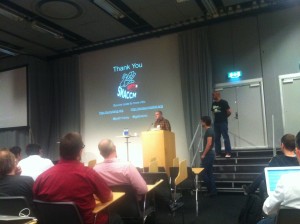
Tower DSL - for organising whole applications. Build on top off ivory, to combine procedures into applications.
The quadcopter story - we have almost build all code in ivory. The bulk of the code is building drivers, that was about 10 kloc, the application was only 3 kloc. We needed to operate with existing the messaging format, we mangled some python code to generate ivory. Totally about 48 kloc.
Evaluation:
The code was delivered to the red team, and now no undefined/buffer overflows etc.. There exists some broad system level issues.
This was a large complex application, but we build high assurance code very quickly. Embedding DSL in Haskell allowed us to build compositional programs.
Source code is at ivorylang.org
Q: You and OCaml both target ARM, so why not us OCaml
A: We wanted compatibility with niche systems
Q: Did you run out of memory ? how do you communication this to the programmer ?
A: We don't currently have way to determine maximum stack depth, we are working on it.
Q: Correct of construction C code, you mean subset of C right ?
A: Yes, no pointer arithmetic
Q: Array handling
A: All arrays are static length
Q: What about error messages for embedded DSL's ?
A: It tough, and we would love to improve it
Q: How do you stop integer overflow ?
A: Using assertions instead of expressing in the type systems. The user can manually add annotations.
Q: Your re-targeted a python script to generate ivory instead of C, how many bugs did you find ?
A: Not sure, its was more clean slate
Concurrent NetCore: From Policies to Pipelines
Speaker: Cole Schlesinger (Princeton University)
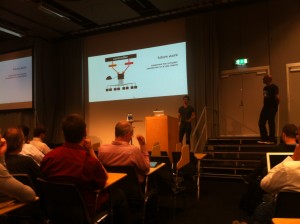 Policy language for describing network policies. A quick intro to basic networking, we traditionally we use distributed protocols such as OSPF but now we have a centralized server to coordinate. We us openflow 1.0, each switch is a simple predicate and action table. There isn't just 1 table, different tables for many difference purposes e.g. different layer. Some switches have reconfigurable pipelines. We are now looking at OpenFlow 2.0 to switch into two phrases: configuration (like flashing router) and population.
Policy language for describing network policies. A quick intro to basic networking, we traditionally we use distributed protocols such as OSPF but now we have a centralized server to coordinate. We us openflow 1.0, each switch is a simple predicate and action table. There isn't just 1 table, different tables for many difference purposes e.g. different layer. Some switches have reconfigurable pipelines. We are now looking at OpenFlow 2.0 to switch into two phrases: configuration (like flashing router) and population.
We have developed a core calculus for pipelines, we have hardware models for 3 switch architectures and add virtual pipelines to our compiler.
The language:
example using the Broadcom trident switch, each table is a function from a packet to a set of packets
The syntax for an example pipeline (trident switch)
W;(all,{port,vport}) ; x:(dst MAC,port) ; if -(vport=1) then y:(vport,port) else id ; z:(all,all)
The control can connect to many switchers, the programmer can express a virtual pipeline as a minimum for each physical pipeline
example controller
m:(typ, port) + r:(dst MAC, port)
We developed 3 general techniques we designed for "RMT" architecture
1. Consolidate packet duplication
2. Refactor field modification
3. find field size
The syntax for the language, see paper. We are inspired by the frenetic family of languages.
We have added concurrency and thus race conditions, we using typing judgements for read and write permissions on each field.
Our normalisation lemma handles rules such as no overlap between read and write sets.
Q: Your plus operator seems to compile after parallelism
A: Its not compiled away just implicit
Session 2: Static Analysis (Chair: Ken Friis Larse)
SeLINQ: Tracking Information Across Application-Database Boundaries
Speaker: Daniel Schoepe (Chalmers University of Technology)
Motivation: Information flow control for computation & database queries. We given data to many complex application that we don't trust. Communication bounds better application is weak spot, so we consider end-to-end. Our contribution is end-to-end information flow with type checker and compiles to F#.
Typically we interface with SQL database, if we don't do it properly then there's lots if issues. Now people write code to generate inference code with SQL
Information flow code should into lead private data. Non- interference means private data channels shouldn't interact with public data channels. Language-integrated query using a toy language (subset of F#) with includes meta-programming. Security policies and security levels are expressed in the type system. We can then annotate databases columns, e.g. name is public but age is private.
Low equivalence relation is equivalence taking into consideration the new types for security levels. We can then use this relation to encode non-interference.
The type system is based on flowCaml, by Pottier and Simonet, 2003.
Our type checker and compiler implementation is written in Haskell using BNFC, we support ADT's .
Using a movie rental database as an example, we consider addresses as private but cities as public. We can query for all rental from a city with public but if we then try to get addresses, the type checker will reject this.
Q: Do you support more complex labelling schemes ?
A: Yes, we support lattices
Q: Can we classify fields or rows ?
A: No
Q: The exists function you demonstrated doesn't depend on type of elements, does it ?
A: No, but we can express that
Q: Do you deal with aggregation ?
A: We haven't considered that yet
Type-Based Parametric Analysis of Program Families
Speaker: Sheng Chen (Oregon State University)
A software system is a family of programs with a configuration, making error messages are difficult to read. We start with a program family, select a program and analysis but variational analysis takes a different route. We will look at the variational analysis today (VA):
Programming by search, applying an analysis gives us results R', but we expected R. We can instead introduce variations to data structures. e.g list -> variational list. Then we adapt analysis, create correctness proof and evaluate performance.
There's a lot of very helpful code extracts, syntax definitions etc.. that I didn't have time to copy, see the paper for them.
Q: In your performance results, did you examples fit into the more or less aggressive approach ?
A: They work even in the more aggressive example
We are breaking for lunch so we'll be back at 2:00
Session 3: Binding Structure (Chair: Tarmo Uustal)
Romeo: A System for More Flexible Binding-Safe Programming
Paul Stansifer (Northeastern University); Mitchell Wand (Northeastern University)
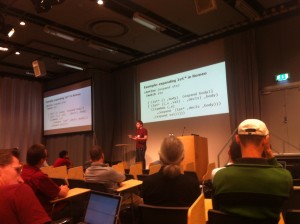 Programming is hard. Meta programming allows us to program to program, but I can introducing name issues. Alpha equivalent inputs, should produce alpha equivalent outputs. We have developed a binding safe programming language, with notation to express complex binding. Romeo expresses binding information in types.
Programming is hard. Meta programming allows us to program to program, but I can introducing name issues. Alpha equivalent inputs, should produce alpha equivalent outputs. We have developed a binding safe programming language, with notation to express complex binding. Romeo expresses binding information in types.
Example remeo code:
stx = (Lamda (a) (+ a 1))
Romeo automatically renames a (as its not exposed) to makes sure no names clash.
Again, have a look at the paper for cool code examples
Romeo is a binding safe language that support term languages with complex binding structure
Q: In meta programming we want effects, how do deal with e.g. meta programming for loop invariant code motion?
A: Remeo is side-effect free, effects in an meta programming we'll take this offline
Q: Is this online ?
A: Not yet
Q: This is very similar to lamdba M ?
A: This was your inspiration but its not powerful enough as we have syntax cases
Q: Hygienic macro expansion ?
A: We indirectly mentioned it
Q: Thanks for getting starting with an example
A: Thanks
Q: What's the complexity of expansing remeo code ?
A: potentially n^2, we think we could perform the substitutions lazily to improve this
Q: can we represent practical thing ?
A: We don't have a story for possible racket macro's you could want, some are simple
Maximal Sharing in the Lambda Calculus with letrec
Speaker: Clemens Grabmayer (VU University Amsterdam)
People desire increased sharing, e.g. to reduce code duplication and check equality of unfolding semantics of programs.
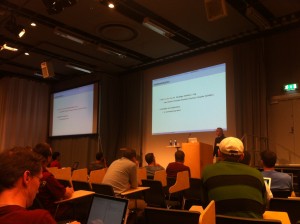 3 Steps:
3 Steps:
- interpretation - turning lamdba-letrec into lambda term graphs
- bisimulation check & collapse of lambda let graphs -
- readback
Our tool is available on hackage
Possible extensions include adding support to full functional languages.
Q: How is this similar to disiding type equivalent in System F?
A: I will look into this
Q: Is this subsumed by Kleene algebra ?
A: I will look into this
Session 4: Program Optimisation (Chair: John Launchbury)
Practical and Effective Higher-Order Optimizations
Speaker: Lars Bergstrom (Mozilla Research)
Many CFA-based optimizations addressed in other ways, but higher-order inlining is the missing optimization. In practice, high performance functional programs avoid functions, e.g. OCaml compiler example.
What is the concrete function called from some computed function call ? (handled by 0CFA)
We have come up with a new analysis to see when can do higher-ordering inlining. We see if any free variables have been rebound between the closure capture location and the call site.
Technique:
- Normalize and number soure code
- Build control-flow graph
- Add CFA-infromed edges
- Perform rebinding
Q: How can I as a programmer understand when the optimisation will kick in ?
A: If your the compiler writer, yes, otherwise we don't yet have a story for this
Q: What happens with things like List.map and List.map ?
A: This are often special case in the compiler to inline
Worker/Wrapper/Makes It/Faster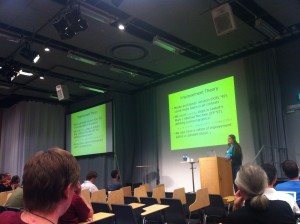
Speaker: Jennifer Hackett (University of Nottingham)
Research focus on correctness of optimisations but there's a lot less work on how we check that the transformation is actually an improvement.
Example of adding an accumulator to th
e List.rev function
The worker wrapper theroms captures induction.
I'm headiing off and direct the reader over to Leo at http://www.syslog.cl.cam.ac.uk/2014/09/01/icfp-2014-day-1/
ICFP 2014: Day 0 (WGP)
The 19th International Conference on Functional Programming will begin tomorrow. Two affiliated events, the 10th Workshop on Generic Programming (WGP) and the Workshop on Higher-Order Programming with Effects (HOPE), take place today.
WGP Session 1
Invited talk: Functional Programming, Object-Oriented Programming and Algebras
Bruno Oliveira (University of Hong Kong)
How to achieve modularity, type-safety and reuse without requiring a PhD in type theory? Bruno Oliveira proposes algebras as an alternative to algebraic datatypes and OO hierarchies, more specifically: variants of F-Algebras. Fold Algebras (using products of functions) and F-Algebras (using sums of products) are isomorphic.
An example of encoding generalized algebraic datatypes (GADTs) using type classes in a way similar to Church encodings due to Hinze from 2003, when there were no GADTs in Haskell.
Similarly, in OO, Church encodings were used to model the visitor pattern.
The Expression Problem: a problem of modularity. Given an existing type of expressions, how do you extend it (e.g. how do you extend data Exp = Lit Int | Add Exp Exp with multiplication)?
Solution 1: encode algebras as type classes, extend using subclasses.
Solution 2: use F-Algebras (Datatypes à la Carte)
In OO languages, can also solve the Expression Problem with algebras: use interface inheritance.
All current solutions using algebras still require heavy encodings. In the future: programming language support for algebras?
WGP Session 2
Generic Constructors and Eliminators from Descriptions
Larry Diehl (presenting), Tim Sheard (Portland State University)
Abstract: Dependently typed languages with an “open†type theory introduce new datatypes using an axiomatic approach. Each new datatype introduces axioms for constructing values of the datatype, and an elimination axiom (which we call the standard eliminator) for consuming such values. In a “closed†type theory a single introduction rule primitive and a single elimination rule primitive can be used for all datatypes, without adding axioms to the theory.
Abstract continued: We review a closed type theory, specified as an A GDA program, that uses descriptions for datatype construction. Descriptions make datatype definitions first class values, but writing programs using such datatypes requires low-level understanding of how the datatypes are encoded in terms of descriptions. In this work we derive constructors and standard eliminators, by defining generic functions parameterized by a description. Our generic type theory constructions are defined as generic wrappers around the closed type theory primitives, which are themselves generic functions in the A GDA model. Thus, we allow users to write programs in the model without understanding the details of the description-based encoding of datatypes, by using open type theory constructions as an internal domain-specific language (IDSL).
Ornaments in Practice
Thomas Williams (presenting), Pierre-Évariste Dagand, Didier Rémy (INRIA)
We often write very similar functions for structurally similar data types, e.g. "add" for natural numbers and "append" for lists. Natural numbers and lists have the same recursive structure and a coherent property, a "length" attribute:
add (length ml) (length nl) = length (append ml nl)
A simple projection function exists from lists to natural numbers: the "length" function.
The motivation for this paper was to add ornaments to ML. Naturals/lists example: an ornament is defined by a projection function from the ornamented type to the bare type, e.g. "length". Declare an ornament as
ornament from length : a list -> nat
The system checks whether recursive structure is preserved.
Syntactic lifting is how "append" can be derived from "add" almost automatically. Given
let rec add m n = match m with | Z -> n | S m' -> S (add m' n)
and the lifting expression
let lifting append from add with
{length} -> {length} -> {length}
the system can derive
let rec append ml nl = match ml with | Nil -> nl | Cons(x, ml') -> Cons(?, append ml' nl)
But the ? is ambiguous (it's the "creative part") and needs to be completed manually, by code inference (heuristically) or a "patch".
A patch would look like
let append from add
with {length} -> {length} -> {length}
patch fun _ -> match _ with Cons(x, _) -> Cons({x}, _)
Applications of this: for refactoring (see question further down), or to derive an evaluation function (uniquely) from "conv", a bijective function between expression types.
More complex data structures can be lifted too (e.g. Sets and Maps); so can higher-order functions. Lifting for GADTs is also possible and is automatic for some invariants given the expected type of the function.
Conclusions: describing ornaments by projection is a good fit for ML, syntactic lifting gives good predictable results. Future work: better patches, integration into ML, combining ornaments.
Q: Projections seem very similar to abstraction functions in abstract interpretation.
A: Could be seen as abstract interpretation.
Q: Is this weaker than what was presented in the 2012 paper? There you could compute ornaments out of indices.
A: Indices flow in the other direction in the presented approach.
Q: Refactoring example. Normally want to throw old code away and keep new code. Here we get some conversion between old and new.
A: Yes, could remove old code.
Q: How about code maintenance?
A: Patches are part of the answer.
Q: Can the patch language also talk about the logical parts?
A: That would not be easy.
Type Inference for the Spine View of Data
Matthew Roberts (presenting), Tony Sloane (Macquarie University)
Context: rho-Calculus (theory of term rewriting), Pattern Calculus and bondi, Stratego, "Scrap your Boilerplate" (SYB paper), kiama, Reloaded/Revolutions.
Motivation: precisely characterize the type inference machinery needed to support the spine view of data.
Result: need to add "ispair" expression (see further down) to first-class polymorphism (FCP), which is a small extension of Hindley-Milner.
Fully applied constructor view means data equals constructor with all arguments (fully applied). When arguments are missing this is a function, so we can't pattern match against it.
Spine view only knows nodes of arity two or zero. This means that all pattern matching can be done using
ispair d bind (x, y) in e1 else e2
which is morally equivalent to
case c of o x y -> e1
_ -> e2
Here x refers to the constructor and all its arguments except the last one, and y is the last argument.
Examples: generic map and fold.
Implementations: the "decidedly generic compiler" dgen and "kiama".
Q: Why is complete type inference so important?
A: The semantics of doing spine view with only one construct took many attempts; this one allows for type inference so it was chosen over the others.
Q: Have you tried to use FCP on other spine view representations?
A: With FCP, you trade off type annotations with data annotations.
WGP Session 3
First-class Isomorphic Specialization by Staged Evaluation
Alexander Slesarenko (presenting), Alexander Filippov, Alexey Romanov (Huawei Technologies)
There are three types of program specialization: partial evaluation, supercompilation and isomorphic specialization. Idea: we have A, B, P such that P : A -> B; also A', B' which are isomorphic to A and B, respectively, and P' : A' -> B' which can be computed more efficiently than P. Potentially there are multiple options for A', B' and P'. How can we use P' on A and B? (A and B: 'domain' data; A', B': 'core' data)
The example used is matrix-vector multiplication. Matrices, for example, can be represented as dense (vector of vectors), This is implemented as an EDSL (embedded domain specific language) in Scala. Here we can abstract over dense and sparse vectors and matrices. The specialization can take place at runtime, and we can allow for alternative specialized versions. Specialization can lead to faster code.
Generic composition of isomorphisms -- idea: build isomorphisms for each constructor in the core language. These isomorphisms are first class citizens of the framework.
How it works: staged method invocation with graphs.
Take-home agenda:
- Develop algorithm in EDSL
- Identify isomorphic representations in the domain language
- Implement ADTs using a core language and isomorphic representations
- Generate representation-specific implementations in the core language
Implementation can be found at github.com/scalan.
Q: How did you proceed? Paper includes theory and implementation notes
A: Original idea was to use graphs, that was the starting point
Q: You talk about large performance increases compared to original Scala implementation. Have you compared with C/C++?
A: No.
Algebraic Effects and Effect Handlers for Idioms and Arrows
Sam Lindley (University of Edinburgh)
Idea due to Plotkin: algebraic effects describe abstract computations. Abstract computations are trees (modulo equations).
Monad trees are unrestricted abstract computation trees (dynamic control and data flow). Arrow trees are monad trees where only static control flow is allowed (static control flow, dynamic data flow). Idiom trees (idiom = applicative functor) are arrow trees where only static data flow is allowed (static control and data flow).
Examples are given for each monad, arrow, and idiom; the control flow and data flow trees show the dynamic / static nature.
Static computations are useful as they allow optimisations and low-level implementations (arrows correspond approximately to circuits, for example).
Key contribution: using Flow Effects, we can write monad/arrow/idiom code in a single style -- this is very different from Haskell, where different notations exist for each.
A handler is an interpreter for an abstract computation. It is defined as a fold over a computation tree, specifying how return values and operations are interpreted. Given a monad handler, we can derive an arrow and idiom handler.
Q: Can it be inferred from a Flow Effects expression whether the computation it defines is a monad, an arrow or an idiom?
A: Yes.
Q: What's the status of the Flow Effects syntax?
A: Not finalised yet -- the syntax shown in the paper is a "mathematical" syntax with braces, indices etc.
A short discussion followed on whether a unifying notation is a good idea -- maybe it is a good thing that we can tell from the syntax whether a computation is a monad, an arrow or an idiom?
Scoping Rules on a Platter -- A Framework for Understanding and Specifying Name Binding
Larisse Voufo, Marcin Zalewski (presenting), Andrew Lumsdaine (Indiana University)
Name binding: for a given reference (use), where is the corresponding declaration (what it refers to)?
In order to understand and unambiguously define name binding rules, a number of name binding combinators has been developed.
Scope combinators are: hiding, merging, opening, weak hiding.
Together they provide a language that describes how scopes are combined to look up a reference. These are then used to describe how a specific language does name binding. The example is C++: the standard devotes over 60 pages in total to name binding rules (and it turns out both Clang and GCC get operator resolution wrong).
Discussant: Ilya Sergey
Q: Could we use attribute grammars for name binding?
A: Finding a grammar for C++ has been attempted many times... It's hard to take a principled approach and applying to C++.
Q: Did you find inconsistencies in the C++ standard when you tried to collect the scoping rules?
A: No, to our surprise -- it's complex but consistent.
Q: Did you come up with any ideas to simplify the rules along the way?
A: There don't seem to be any ways to simplify the rules (except using a different language).
WGP Session 4
Composing and Decomposing Data Types -- A Closed Type Families Implementation of Data Types à la Carte
Patrick Bahr (University of Copenhagen)
This paper was inspired by the recent addition of closed type families to the Glasgow Haskell Compiler (GHC). Closed type families were used to implement Data Types à la Carte, specifically the subtyping constraint :<:
Data Types à la Carte -- idea: decompose data types into two-level types. Express recursive data types as the fixpoint of a functor. These functors can be combined by coproduct construction :+:.
Example:
-- recursive data type data Exp = Val Int | Add Exp Exp -- as fixpoint of a functor data Arith a = Val Int | Add a a type Exp = Fix Arith -- combine by coproduct construction data Mul a = Mul a a type Exp' = Fix (Arith :+: Mul)
The subtyping constraint is easily expressed as a type class with an injection function inj and a projection function prj. But this approach treats :+: asymmetrically, doesn't inspect the left-hand side and is ambiguous.
Contribution of this paper: a re-implementation of :<: which behaves as expected (f :<: g <==> there exists a unique injection from f to g), avoids ambiguous subtyping (by rejecting multiple occurrences of signatures) and allows expressing isomorphism.
Implementation: Have a type-level function Embed taking signatures f, g as arguments. Produces proof object p for f :<<: g -- a relaxed version of :<: allowing ambiguity -- and checks whether p proves f :<: g. We can then derive implementations of inj and prj using the proof object as an oracle in instance declarations.
The code for Embed, Sub and helper type classes is shown. It's all contained in the "compdata" package.
Caveats: unhelpful error messages; compile time performance is unpredictable.
Discussant: Wouter Swierstra
With this approach we gain lots of expressive power, e.g. control over how the search proceeds, at the price of more type level programming.
C: A solution for the error messages apparently exists. Also, Idris does this really nicely (it's also much more complicated).
Q: Motivation: want to use sums of products. Interesting tradeoff by maybe focusing on coproducts of products?
A: ?
Q: Would instance chains have solved your problem?
A: Yes.
Q: All this type hackery for deriving injections and projections -- how about just providing them every time?
A: Of course you can do that, but it's inconvenient and obvious from the type. If you need more flexibility, you can still do it manually.
Q: No canonical ordering for injection (eg sum of int and bool) -- is this a problem?
A: Yes, at the moment you have to annotate.
True Sums of Products
Edsko de Vries, Andres Löh (presenting) (Well-Typed LLP)
A new approach to datatype-generic programming in Haskell; notable features: faithful representation of datatypes as n-ary sums of n-ary products; a library of high-level combinators to encourage concise and reusable functions; separation of metadata in the representation.
Available on Hackage as "generics-sop". "basic-sop", "lens-sop" and "json-sop" provide examples, generic lenses and generic JSON (de)serialization respectively.
Motivation was to improve on existing models: GHC.Generics representation is too constrained (binary sums and products) but at the same time too flexible (arbitrary nesting). Also has noisy metadata everywhere. Functions end up making implicit assumptions about the structure of the data which is not guaranteed by the type system.
Discussant: Patrik Janssen
Q: What kind of code does this generate?
A: Not looked at yet. But lots of implicit arguments are potentially being passed around at runtime.
Q: Can this be done better in Agda?
A: Library was completely developed in Haskell. Can probably be done more nicely in Agda, but in this case the development was driven by an actual need to deal with certain generics problems in Haskell.
Q: n-ary lists are left-biased: don't you run into similar performance problems as with binary representation?
A: List-based representation gives uniform encoding for all constructors. But probably not ideal for data types with thousands of constructors.
Liveblogging OCaml Workshop 2013
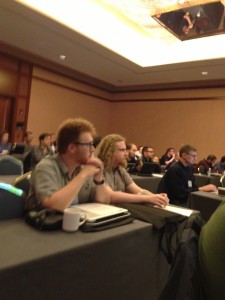 I'm here bright and early at the OCaml 2013 workshop at ICFP with Heidi Howard, Leo White, Jeremy Yallop and David Sheets! Â There's a packed session today with lots of us presenting, so we'll swap over editing this post as the day progresses. Â I also need to pop out to attend a panel on the future of Haskell so I'll be missing the bindings session, sadly!
I'm here bright and early at the OCaml 2013 workshop at ICFP with Heidi Howard, Leo White, Jeremy Yallop and David Sheets! Â There's a packed session today with lots of us presenting, so we'll swap over editing this post as the day progresses. Â I also need to pop out to attend a panel on the future of Haskell so I'll be missing the bindings session, sadly!
